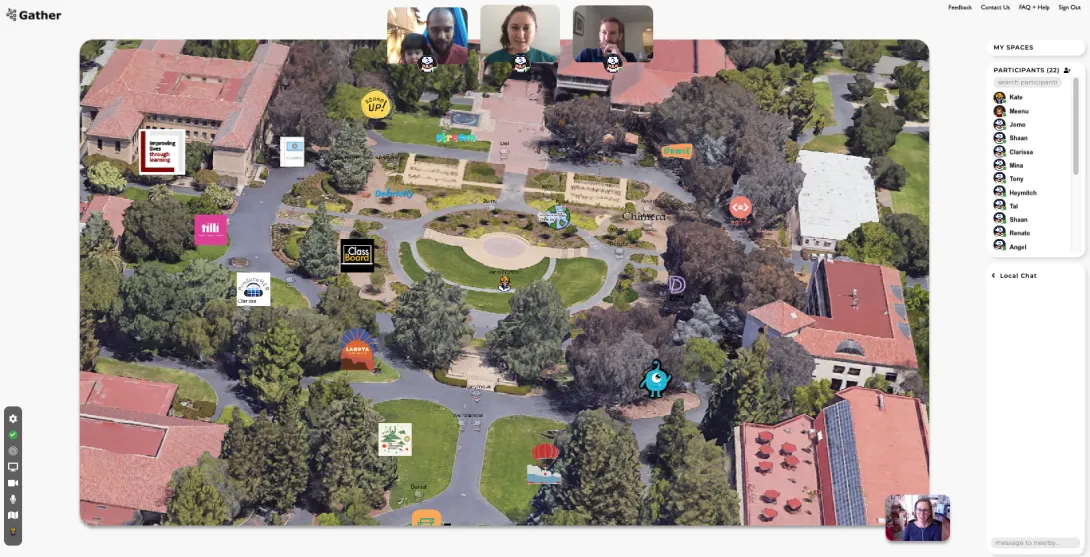
Stanford education program pilots a new way to showcase inventions
Every year around this time, hundreds pack the Center for Education Research at Stanford to check out new learning tools invented by students in the Graduate School of Education’s Learning, Design and Technology (LDT) program.
At the bustling Expo – which draws a crowd of education and tech professionals, potential investors and curious community members – students demo their prototypes of mobile apps, teaching aids, educational toys and other products, many of which have gone on to market in past years.
It was clear the in-person event would be out of the question this summer. But having spent the past year coming up with novel approaches to learning challenges, this group was primed to find a clever way to bring the gathering online.
“At its core, the Expo is a learning experience, and that’s what our program is all about: designing learning experiences enhanced by technology,” said GSE lecturer Karin Forssell, MA ’92, PhD ’11, who directs the LDT master’s program. “We decided to apply our own design process to this experience, to practice what we preach.”
The program uses a design thinking process for creative problem solving: understand your learners and what they need, brainstorm solutions, develop a prototype and try it out.
It seemed only fitting to bring that approach to the Expo itself.
“There’s something very meta about it,” said Forssell, who also directs the GSE Makery, a studio for hands-on learning that has been offering workshops online during the pandemic.

On a virtual Stanford campus, attendees can navigate from booth to booth, listening in to conversations as they approach and choosing which to join.
Finding out what users need
To get more insight into what the LDT Expo means for the people who participate, Forssell embarked on a need-finding mission by interviewing past attendees – especially program alumni, many of whom work in the edtech field.
“This event is definitely about showing off what the students have developed, but it’s also much more than that,” she said. “It’s a celebration. It’s a reunion. So I wanted to find a way for everyone to interact with each other and have some freedom of movement, even if it’s on a two-dimensional screen.”
She surveyed her students about online tools they’d used in other classes that might help create this experience. She also reached out to the GSE’s staff of digital learning specialists to explore the pros and cons of various platforms.
Forssell opted to work with a new start-up, Gather, which has developed a tool to set up virtual gathering spaces for different settings such as conferences, offices and college campuses. Together they customized the platform design for the LDT Expo experience.
‘You can see where the action is’
A key feature is the ability to scope out a room where multiple conversations are taking place and then listen in to one before deciding to join. As a user, you choose an avatar and give it your name, then move around the space like a character in a video game. When you approach a cluster of two or more avatars talking, you begin to overhear the conversation; your personal audio stream switches from silence to the conversation taking place nearby. You can either join them or keep walking.
“You can see where the action is, and where there’s an opening,” said Forssell. “You might see someone you want to talk to who’s not talking to anyone, so you can head over to connect with them in the space.”
The LDT program took the platform on a trial run at their virtual graduation ceremony in June: Forssell set up an online space for a mini after-party, where attendees could explore the tool and continue talking with whomever they chose.
“One of the things about the Expo is that it’s an opportunity to try out new things, even if they’re a little less polished,” said Forssell. “Maybe it refines your understanding of the problem. Maybe it sends you looking for other tools. It’s all part of the design process.”
The 2020 LDT Expo takes place on Friday, July 31, from 4 - 6pm PDT. See a preview of this year’s projects, and register to join the event.
Faculty mentioned in this article: Karin Forssell



